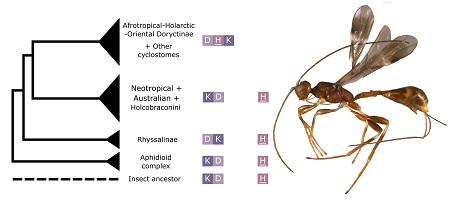Subfamily Doryctinae constitutes mainly parasitoid and some phytophagous braconid wasps. Molecular studies recovered a non-monophyletic Doryctinae. We characterised several mitogenomes and conducted phylogenetic analyses to assess the monophyly and higher-level classification. We identified rearrangements of mitochondrial transfer RNAs that support a non-monophyletic Doryctinae constituting two separate unrelated clades, also supported by phylogenetic analyses of mitogenome and nuclear data. Utility of the mitogenome rearrangements was highlighted as a potential source of phylogenetic information at different evolutionary timescales. (Image credit: Rubén Castañeda-Osorio.)

Invertebrate Systematics
Volume 38 Number 5 2024





